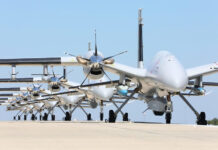The Commander of the Israel Air Force, Maj. General Elyezer Shkedy discussed the role of the air power in confronting challenges in fighting terror, speaking at the 4th Global Air Power Conference held in Singapore on Feb 18. The Israeli general presented some of the achievements of the Air Force, the results of meticulous preparations that started following the 1991 Gulf War, when Israel was pounded by repeated attacks of Iraqi SCUD missile, which neither Israeli, nor the U.S. led coalition forces could track, locate or destroy.
During the second war in Lebanon, in 2006, the Israeli Air Force managed to destroy within few hours, the entire long and medium range missile force secretly deployed by Hezbollah, hidden in protected, secured locations throughout the country. General Shkedi illustrated the complex and challenging aspects of fighting asymmetric warfare, with the Israeli Air Force engaging enemy targets as they seeked shelter near, or within populated areas, in mosques, schools or hospitals. To address those challenges, Israel developed unique capabilities enabling rapid decision making, with aerial platforms seeking to destroy time critical targets within less than a minute. According to Shkedi, almost every medium range multiple launcher rocket was hit and destroyed within 1-7 minutes from the time it launched the first rocket.
One such example was demonstrated in a video, showing a multiple rocket launcher firing only four rockets before it is hit and destroyed by Israeli precision guided weapons.
Other examples introduced by the commander, demonstrated electro-optically guided weapons, providing a crisp view of targets concealed in foliage, as the missile’s nose mounted camera unveils the hidden target as it closes-in for the kill. Neither the Second Lebanon War or the current ongoing conflict with the Palestinians in Gaza have provided decisive results but General Shkedi argues that the facts prove the viability of airpower in fighting terrorism – “As the Israel Air Force improved its process, gaining more significant role in the fighting over Gaza. This capability eventually led to a decision to withdraw from the Gaza Strip in 2005, in the so called ‘Disengagement’ which, unfortunately did not bring peace and quiet to the area. Since then, the Air Force was the dominant force in the area, culminating in 54% of the terrorist kills in 2007. “In specific operations the Air Force achieved 70% of the kills” said Shkedi.
He also emphasized that in the decision to employ airpower Israel did not compromise on reducing collateral damage and risk to innocent lives. As we improved our methods of operations, collateral damage was reduced from a ratio of 1:1 in 2002 to an average of 98 terrorists killed with a single innocent killed in the second half of 2007. This has happened while air activity over Gaza increased dramatically during this period.
However, Shkedi is cautious about emphasizing the counter-terror role of air power, while neglecting other levels of warfare. Air power has relative advantages in a limited, low intensity conflict. But this is only one facet of modern warfare – we are facing other challenges, including high intensity conflicts with neighboring countries where the Israel Air Force is required to establish air dominance, and more distant threats, from countries with whom we do not share borders, where air power provides the major relevant force.



















